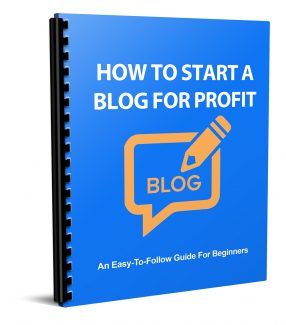 License Type: Master Resell Rights
License Type: Master Resell Rights  File Type: ZIP
File Type: ZIP
 SKU: 60419
SKU: 60419  Shipping: Online Download
Shipping: Online Download
Sample Content Preview
How To Start a Blog For Profit
An Easy To Follow Blogging Guide For Beginners!
A blog needs to be monetized to generate revenue. It should be a successful blog with a growing base of subscribers to keep generating more revenue. Only then would you have a profitable blog. Any blog can be monetized but there may be no revenue. Any blog can have some revenue but only consistent and sustainable revenue over a period of time will ensure profit. The fact that anyone can start a blog with little or no capital, the availability of a plethora of free tools, the ease with which one can get started and equal access to the audience ensures only the best would win. The competition has never been this stiff.
In this comprehensive guide for beginners we lay out the simple steps one must take to start a blog for profit.
Setting up the Blog
You can design a website from scratch, which should be easy if you are a programmer. If you have no expertise in coding or website design, then you should consider a content management system like WordPress. WordPress is free and it is the most popular blogging platform today. The open source software which is used by more than a hundred million people can be hosted for free using the WordPress platform or you can host it on your own. You can opt for shared hosting or dedicated hosting.
You may have your own server and configure it to host a site if you know the technicalities. The best strategy is to go for a WordPress site and shared hosting. You can move to dedicated hosting in the future when you make more money as it is substantially more expensive than shared hosting.
Getting started with WordPress is pretty simple. You can download WordPress directly from the official site and start building your blog using the simple guidelines. Or, you can choose a webhost and a shared hosting plan that supports WordPress. The control panel of the hosting account will get you WordPress. Thereon you can build your blog from within the website builder offered by the webhost. Even as you pay for the shared hosting plan, WordPress would still be free. If you don’t wish to pay for hosting, opt for WordPress directly and use its free hosting platform. This will have its limitations in term of bandwidth, storage and site features but you can keep your initial investment contained.
The following steps will illustrate how you would start a WordPress blog using a webhost.
• Choose a webhost and a shared hosting plan. Go to the website of the webhost and sign up for the plan. Provide all the details you are asked for, get a domain name if you don’t have one already and make the payment to get access to your exclusive control panel. Most webhosts will offer a free domain with a shared hosting plan.
• Set up your account, choose the password, the features you want and check into the Site Builder section. You will get the WordPress icon. There will be many options in the Script List such as Backups, Utilities and Blogs. You would find WordPress in the Blogs section. Click it, get redirected it to the installation page and install it.
• Use your domain name and set up your WordPress site, the blog which will be blank at this stage. You would have to work on the layout, design, features including plug-ins and everything from font to the unique elements of your blog. Don’t worry as there are drag and drop options from WordPress and from most webhosts that you can use to create your blog. You don’t need to write a single line of code.
Monetization of the Blog
You could use your blog for paid blogging. There are companies and individuals that want their products, services or entities to be promoted. These would normally pay a price for every blog post. You could take this route or you can write about what really interests you and think of monetizing the blog using advertisements. You can consider affiliate marketing, which is essentially blogging to promote and endorse certain products or services. When the audience you are targeting or your readers check out the post and click on links redirecting them to the official pages of those products or services, you would get paid. There are programs paying you for every user that clicks on the links and gets redirected. Other programs pay you a handsome commission should the users sign up for the service or purchase the product after being redirected from your blog.
There are a few quintessential elements of starting a blog for profit.
• You need to attain popularity. You cannot make money when your blog doesn’t have any dedicated readership. You need a loyal audience that would keep returning to your blog and would keep checking out new contents that you upload. The audience cannot be limited to a few dozen people and it cannot be sporadic. You cannot rely on rerouted traffic. Your blog must be popular and obviously it would have its target audience. The target audience shouldn’t have to search for something and then get to your blog. They would follow your blog. You don’t need all those readers to become subscribers or commentators. As long as they follow your blog and repeatedly visit it, the blog can be monetized. An unpopular blog or one that doesn’t have a substantial readership can have ads or affiliate links but the monetization will not generate any revenue.
• You need consistent traffic as that will pave the way for advertisements, paid contents and promotions which will help you to make money with your blog. Without traffic, posting ads or optimizing new contents and sharing of the content will be futile. The nature of the traffic, the target audience and the kind of outreach a blog has along with the focus or the niche will determine the type of ads, promotions and paid contents. A blog shouldn’t lose its value or core in the process of monetization.
• There are many ways to make money with a blog. You could offer free content to entice the audience and then offer exclusive or academic content for those who want more information and would be willing to pay a subscription fee. You could just use the readership and get paid through ads, affiliate marketing links, sponsored banners and all kinds of product and service placements on every webpage of your blog. You need a strategy that will allow you to target your niche readership while monetizing the entire space available on every webpage of your blog. From banner ads to sponsored posts, affiliate links to promoted contents, pay per click ads to paid promotional posts; you should consider every prospect of monetizing.
Targeting Readership/Subscribers
Every blogger can get their friends and family to become the first subscribers. Sharing a few posts will get some lost social contacts to start following the blog but not everyone may be reading all your posts. No one can use their personal contacts and social connects to get the thousands of readers that one needs to actually monetize a blog for profit. You need to target a thousand subscribers or readers, then two thousand and then five thousand till you can grow enough to become a formidable blogger.
Let us first address how you should facilitate the signing up or following of new subscribers and readers.
• There should be social media plug-ins to facilitate immediate following, liking and sharing. There should be opt in sections where readers can provide their email address and sign up for the blog updates, newsletters or emails and other types of communications. Aside from the RSS feed and other obvious plug-ins you should have a simple popup asking if the reader or visitor will want to get notifications from the blog. This may happen on a traditional browser, mobile browser or via social network, media and apps. Notification has become an alternative to the conventional following.
• Don’t ask for more details than what you need. Social media plugins immediately connect visitors to the blog using their existing credentials. Use email authentication or social media authentication instead of asking for email address, first name and last name, city and other unnecessary details. Your blog is not building a database of readers. You simply need a following to get a substantial readership.
• Always have a call to action on every webpage. Many bloggers opt for standard calls to action, suggesting they share the post or like, comment or check out more posts. While these are acceptable, you should think of unique calls to action. Host polls, get people to agree or disagree, encourage readers to write counterpoints so you can take the discussion further. Every blog post can become an asset provided it has enough stuff to trigger a conversation and subsequent engagement with a larger audience. A blog post that doesn’t generate any traction is a waste of space and effort.
• Incentivize your followers to entice more. Offer something to your new readers so they would be inclined to follow you or become subscribers. Give something precious, which could be rare tips or some insider knowledge, to your existing readers so they continue to follow you and read what you post. Today, not many people are interested in following for the sake of following unless they get rewarded in some way.
You will use your social media profiles and presence on multiple social networks to get more readers or subscribers. That would still limit your outreach unless you take a few quintessential steps. These are to be factored in at the time of starting a blog because otherwise you would need to rethink everything, right from your blog layout to the kind of content you are penning down.








